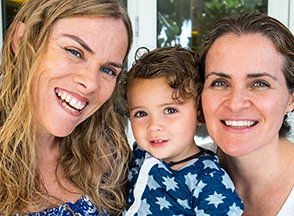LGBTQ Stepparenting
 Becoming a stepparent is an exciting, unique experience that’s often accompanied by nervousness, anxiety, frustration, and doubt. Lesbian, gay, bisexual, transgender, and queer stepparenting may be particularly challenging due to the lack of resources available to this specific demographic. These new stepparents are entering diverse family structures that might have previously been headed by heterosexual parents or a single parent, and which might include their partners’ biological or adopted offspring. By tapping into resources and applying different strategies, LGBTQ stepparents and their partners can alleviate some of these feelings and frustrations, and simply focus on their families.
Becoming a stepparent is an exciting, unique experience that’s often accompanied by nervousness, anxiety, frustration, and doubt. Lesbian, gay, bisexual, transgender, and queer stepparenting may be particularly challenging due to the lack of resources available to this specific demographic. These new stepparents are entering diverse family structures that might have previously been headed by heterosexual parents or a single parent, and which might include their partners’ biological or adopted offspring. By tapping into resources and applying different strategies, LGBTQ stepparents and their partners can alleviate some of these feelings and frustrations, and simply focus on their families.
You are Not Alone
In a 2013 study, researchers examined the lives and experiences of lesbians and gay men who were parenting as the primary parent or stepparent after leaving a previous heterosexual relationship. One of the most significant findings was that these parents often face the same challenges and successes as separated or divorced parents entering into new heterosexual relationships. The study also found that children of divorced parents were all equally healthy, happy, and successful in school, regardless of the sexuality of their parents. Additionally, having a parent in a new same-sex relationship seemed to help children be more accepting of diverse family arrangements.
This is not to say that LGBTQ stepparenting is easy; the challenges facing nearly all stepparents also apply here. First, the family must acknowledge and address the losses experienced by the children and adults. Then, family boundaries, roles, and rules must be discovered. Strong communication must be built, and a balance of power between and among the family members must be established.
Children who have faced family disruptions may need extra help and time as they encounter these transitions. Fortunately, many resources are available to help step and blended families create strong, lasting relationships as they navigate these challenges.
Strategies to Help LGBTQ Stepparents
Despite their similarities to heterosexual divorced/separated parents and non-parent LGBTQ adults, LGBTQ parents and stepparents still deserve resources designed specifically for them. Some strategies of particular importance to this community include the following:
*Discuss the roles each adult will take in the family.
This is important for all parent/stepparent couples, but especially for LGBTQ families, where expectations may be complex due to the question of whether a stepparent will fill the role of an opposite-sex parent. Remember that the keys to success are support, communication, and balance. No one parent need take on a traditional “mother” or “father” role in order for the family to be complete, healthy, and whole.
*Educate yourself on the custody and adoption laws in your state.
Does your state favor the heterosexual parent for primary custody? If so, what resources will you need to assemble to deal with this? Will your new partner be able to legally adopt your child(ren) as the secondary parent? Additionally, is this something that you both wish?
*Build the largest family support network you can!
Extended family members from multiple generations can be invaluable in helping you feel connected as a family. Reach out to friends and community members as well, to alleviate stress and help create balance.
*Build a personal support network.
Connect with other LGBTQ adults, whether they are parents or not. Those who come out later in life will have larger social, family, and work networks to navigate, and will need to take care of themselves emotionally to help establish healthy relationships with your partner and family. Positive support will help with this process.
*Prepare yourself and your child(ren) to deal with social stigmas, heterosexism, and homophobia.
How will your child(ren) respond if someone insults them or you? Will you engage their teachers on this topic preemptively, or only if a problem arises? Having a plan can help your family manage stress and disruption. The good news is that children of LGBTQ parents who come out later in life are generally both accepting of their parents and accepted by their peers.
LGBTQ-headed step- and blended families can be just as successful, happy, and valid as any other type of family structure. While specific resources are sometimes scarce for new LGBTQ stepparents and parents of blended families, tapping into existing resources can provide a wealth of information adaptable to each unique situation.
By Leslie Hamilton, M.S. candidate, Department of Family, Youth and Community Sciences, University of Florida, and Carol Church, lead writer, SMART Couples, Department of Family, Youth and Community Sciences, University of Florida
References
Noller, P. & Atkin, S. (2015). Family environment and adolescent development. In Family Life in Adolescence (pp. 34-66). Berlin: De Gruyter Open. Retrieved from here.
Tasker, F. (2013). Lesbian and gay parenting post-heterosexual divorce and separation. In Goldberg, A.E., and Allen, K.R. (Eds.), LGBT-parent families: Innovations in research and implications for practice,3-20. New York, NY: Springer Science+Business Media. Retrieved from here.
Reviewed by Krista Hunt and Sheyla Pena
Courtesy of University of Florida UF/IFAS Extension. For more relationship articles, visit www.smartcouples.org